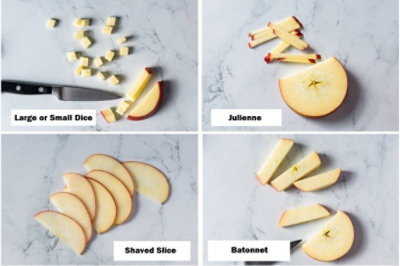Large or Small Dice
The best way to get a square shape out of a round apple is to cut the apple crosswise, stack a few slices on top of each other and cut into cubes, discarding the center core pieces. Be sure to cut your apples the same size as other items in your dish to makes the eating experience more pleasant. When cooking apples, use a large dice if you want the apple to retain some of its shape after cooking and a small dice if you would like the texture of the apple to be soft and “disappear” in the dish.
Julienne
Otherwise known as matchsticks, this cut is a favorite for salads; it makes an interesting presentation, adds a nice textural crunch but is still easy to eat due to the thin cut. This cut is approached the same way as the dice; by stacking apple rounds and making thin slices.
Batonnet
The batonnet cut is similar to the julienne cut, only larger, like a French fry. This is a unique way to cut apples for serving alongside a dip instead of the standard wedge.
Shaved Slice
This is technically not an official culinary size, but since slicing is a common way to cut apples, we thought it deserved an honorable mention. A shaved slice is just a paper-thin version of the typical slice of apple and is best done with a mandolin if you have one. Alternatively, you can cut thin slices by hand, carefully, with a very sharp knife. Shaved apples are wonderful in dishes that have lots of other ingredients in it because they are thin enough to spear on your fork with another piece of food, which enhances the texture and flavor of every bite.












